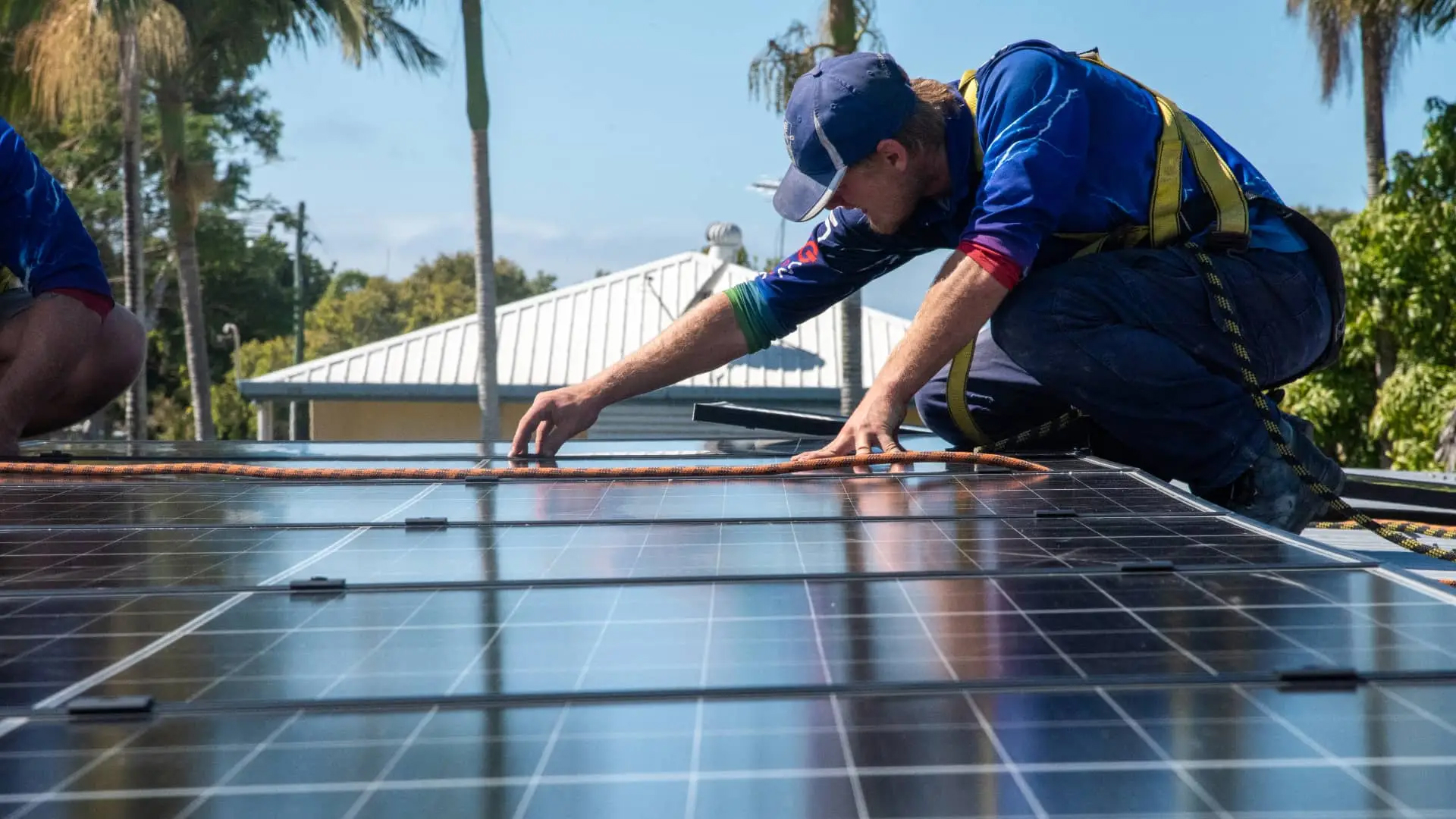
If you’re considering adding a battery to your solar setup, you’re not alone. Solar batteries are becoming increasingly popular across Queensland, especially in sunny regions like Mackay and the Sunshine Coast. But if you’ve ever wondered how solar battery installation actually works—or whether any electrician can do the job—the short answer is: there’s a lot more to it than meets the eye.
Here’s a straightforward guide to everything you need to know before installing a home or business solar battery, with answers to the most common questions we hear at Snap Solar.
Not Just Any Sparkie Can Do It
Let’s start with a big one: not all electricians are qualified to install solar batteries. While most licensed electricians can wire a standard switchboard or install solar panels, solar batteries come with an entirely different set of standards and requirements.
Because solar batteries store energy and pose additional fire and electrical safety risks if installed incorrectly, installers must be accredited for battery work specifically under Solar Accreditation Australia or the Clean Energy Council.
These accreditations ensure that your battery setup is compliant with Australian safety standards—which are among the strictest in the world—and help you qualify for any available government incentives or rebates now or in future.
So What’s Different About Battery Standards?
Installing a solar battery isn’t just about plugging something into the wall. The job has to comply with various Australian standards like:
- AS5139:2019 Electrical Installations: safety of battery systems for use with power conversion equipment – covering battery energy storage safety
- AS4777.2:2020 Inverter Requirements standard – for grid-connected inverter performance
- AS5033:2021 Installation and safety requirements for photovoltaic (PV) arrays – governing solar panel arrays
- AS4509:2009 Stand-alone power systems, safety and installation – for off-grid systems, where relevant
These codes ensure your system works safely, integrates properly with the grid, and won’t put your family or property at risk. It’s also how you ensure your system is eligible for future rebates or performance guarantees.
Where You Can—and Can’t—Install a Battery
One of the most common questions we get is about battery placement. Can you put it outside? Can it go in the laundry? What about the garage?
Here’s the deal: solar batteries can be installed indoors or outdoors, but not just anywhere. For example, you can’t install them in a habitable room—like a bedroom, living room, kitchen, or home office—because of safety concerns around fire risk and ventilation.
Most homeowners choose areas like:
- Garages (with mechanical protection if needed)
- Dedicated battery rooms
- Covered verandas
- Outdoor walls (as long as shade and clearance rules are met)
Outdoor installations must also consider Queensland’s hot climate. Since excessive heat can shorten your battery’s lifespan or reduce its performance, we typically avoid north- or west-facing external walls in places like Mackay where summer temps can soar. Battery systems have optimal operating temperature ranges, and correct placement helps you get the most out of your investment.
AS5139 Explained: Battery Clearance and Barrier Requirements for Home Installations
Clearance and fire safety go hand-in-hand when it comes to installing your home solar battery—especially in residential environments.
According to Australian Standard AS5139, every battery system must meet strict minimum clearance guidelines to ensure safe operation and reduce fire risk.

Source: Clean Energy Council
Specifically, the battery must have at least 600mm of lateral clearance (side-to-side) and 900mm of vertical clearance (above the battery), or more if the battery manufacturer specifies a greater distance.
These gaps aren’t just for show. They provide airflow and help prevent heat build-up for the battery, which is especially important in Queensland’s warmer climate.
The reason for these strict guidelines is that most solar battery systems use lithium-ion technology, which, while highly efficient, can be susceptible to thermal runaway—a chain reaction of overheating that may lead to fire if left unchecked. While many manufacturers (such as Hinen) now include built-in fire suppression systems to manage this risk, the placement and surrounding conditions of your battery still play a critical role in safety.
If your battery is installed on a non-combustible base like a concrete slab or mounted against a wall made from “deemed to comply” materials (as defined in the standards), no extra fire protection may be needed.

Source: Clean Energy Council
But if the required clearance from a habitable room—such as a bedroom, lounge, or study—cannot be achieved, then a non-combustible barrier must be installed. This barrier acts as a fire-resistant shield between your battery and the adjacent living space, and its design must comply with Section 4.2.4.2 or 5.2.4.2 of AS5139.
It’s also important to note that batteries cannot be installed within 600mm of any doorways or emergency exit paths (known as egress paths).
However, if the battery is placed at least 300mm away from a wall that separates it from a habitable room, and that wall is constructed to standard, additional protection may not be required.
These location and spacing rules are all about minimising risk and maximising safety, and Snap Solar ensures every installation is assessed for compliance. Not just to meet regulations, but to protect your home and your peace of mind.
Installing a Battery in Your Garage? AS/NZS 3000 Mechanical Protection Is a Must
Mechanical protection is another important consideration—especially if your battery will be installed in a garage or anywhere vehicles regularly move.
In Queensland and across Australia, many home battery systems are placed in areas where accidental impact is a real possibility. According to the AS/NZS 3000 Wiring Rules, if there’s a reasonable expectation that a battery could be damaged by a vehicle—such as being bumped while reversing—then mechanical protection is mandatory.
This could involve installing a bollard, guard rail, or another physical barrier to shield the battery from impact. While some battery enclosures have been tested for impact resistance, the standards still require that installers take precautions based on location and risk. Snap Solar’s team always factors this in when designing your system layout, so your battery is not only high-performing and efficient but also safe, secure, and compliant from day one.
Battery Inverter or Hybrid Inverter—What’s the Difference?
When it comes to making your battery functional, you’ll need an inverter to convert the stored DC energy into usable AC electricity.
- A battery inverter is installed alongside your existing solar inverter
- A hybrid inverter is a two-in-one unit that manages both solar panel generation and battery storage
If you’re starting fresh or planning a future upgrade, hybrid inverters are often more cost-effective long-term. But both options can work—Snap Solar will help you choose based on your home, system design, and budget.
Real-World Options: Batteries We Recommend and Install
When it comes to choosing the right battery for your home, Snap Solar offers a curated range of industry-leading systems designed to meet Australian safety standards, perform reliably in Queensland’s climate, and scale with your energy needs.
One standout is the BYD Battery Box range, particularly popular among homeowners because of its modular design and exceptional safety record. Whether you start with a BYD LVS, a flexible unit that ranges from 4 kWh up to a massive 256 kWh, or opt for the HV model with its high-voltage backup capabilities and seamless integration with top-tier inverters, both options are scalable—so you can start small and grow over time.
For a more premium, fully integrated experience, there’s the Tesla Powerwall 3. It combines cutting-edge lithium iron phosphate chemistry with a built-in inverter, intelligent energy management via the Tesla app, and smart features like Storm Watch mode, which fully charges your battery in anticipation of severe weather events. With 13.5 kWh of storage and advanced monitoring tools, it’s perfect for homeowners who want full visibility and control over their energy use.
Another excellent performer is Sungrow’s solar battery lineup, which offers 9.6 to 25.6 kWh of capacity with high efficiency, fast backup response, and durable, weather-tolerant hardware. These batteries are designed to deliver strong, consistent performance even in Queensland’s variable temperatures and can be a cost-effective solution for families looking to reduce grid reliance without breaking the bank.
Whether you’re after modular flexibility, intelligent tech, or hard-working durability, Snap Solar can help match you with a battery that fits your energy usage, property layout, and long-term goals—all while ensuring compliant installation and expert support every step of the way.
Is it Better to Buy the Biggest Battery I Can Right Now?
Yes, it’s a good rule of thumb to aim for the largest battery you can reasonably afford—within your financial comfort zone.
With support options like interest-free loans (ask us about this if you’re interested) and the upcoming Cheaper Home Batteries Program, upgrading your storage capacity is more achievable than ever. But it’s still important to consider your overall budget, cash flow, and long-term financial goals. It’s always wise to leave yourself a buffer—especially if you’re managing multiple expenses.
That said, even if your budget only allows for a smaller solar battery right now, it’s still well worth the investment. Any battery is better than none when it comes to reducing reliance on the grid, storing excess solar power, and protecting yourself from rising energy prices.
And the good news? Many systems—like the BYD modular battery range—are designed to grow with you. You can start small and scale up later, adding more capacity when you’re ready, without having to overhaul your entire setup.
How Much Battery Storage Do I Need to Go Off-Grid in Mackay, Sunshine Coast, or Cairns?
Thinking about cutting the cord from the grid entirely? You’re not alone—and with Queensland’s abundance of sunshine, it’s a tempting goal. But to go fully off-grid in places like Mackay, the Sunshine Coast, or Cairns, your system needs to do more than just generate power—it needs to store enough of it to get you through the night, cloudy days, and even a full week of bad weather.
Let’s start with the numbers. Most Australian households use anywhere from 15 to 25 kilowatt-hours (kWh) of electricity a day. If you’ve got a bigger home, a pool pump, or a household full of gamers and air-con lovers, you might chew through 30 to 50 kWh daily without even trying.
So, what does that mean for battery storage?
If you’re aiming for true energy independence, most homeowners will need at least 30–40 kWh of usable storage to go off grid. That gives you enough to power essentials overnight and handle an overcast day or two. For larger homes—or if you want to run air-con, fridges, and appliances like normal without worrying—you’re looking at 50–60 kWh or more.
Now, don’t forget climate matters. In Mackay and Cairns, the humidity and storm season mean your battery system should be cyclone-resilient and possibly include a backup generator. Over on the Sunshine Coast, you’ll deal with more variability in weather—clear skies one week, rain the next—so having a bit of extra storage can make life a whole lot easier.
More Solar Panels or More Batteries—Which Should You Choose?
It’s one of the most common questions we get: “Should I spend more on solar panels or invest in bigger battery storage?” And the answer? It really depends on what you’re hoping to achieve.
If your main goal is to cut your power bill and make the most of Queensland’s sunshine, more solar panels are a smart first step. They’re generally more affordable, faster to pay off, and can reduce your daytime energy costs dramatically. Got a generous feed-in tariff in your area? Even better—you can send excess power back to the grid and shave even more off your bill.
But panels only go so far.
If you want energy when the sun isn’t shining, or if you’re aiming for blackout protection and energy independence, a battery becomes your new best friend. Battery storage lets you keep your excess solar power for evening use—so instead of feeding cheap power into the grid and buying expensive energy back later, you store it and use it when it suits you.
Of course, batteries are pricier. They have a longer payback period and can feel like a big upfront investment. But for many Queenslanders, the value isn’t just in dollars—it’s in resilience, peace of mind, and reducing reliance on a volatile grid.
Here’s our take:
- Want quicker savings? Go for more panels.
- Want more freedom and backup power? Prioritise batteries.
- Want the best of both? Get a balanced system with both panels and scalable storage.
The latest Federal Solar Battery Rebate will also make new solar battery installations more affordable, with around 30% off solar battery installations to upgrade existing systems, add on power, or supplement a new solar system installation.
Final Thoughts: Batteries Are Smart, But Installing Them Smarter Is Key
Adding a battery to your solar system is a big investment—but it’s also one of the best steps you can take toward energy independence. The key is making sure it’s done right—by qualified, accredited professionals who understand Queensland conditions, compliance rules, and the latest battery technologies.
At Snap Solar, we’re here to make sure your battery installation is safe, future-ready, and built to last. Whether you’re just starting out with solar or adding storage to an existing system, our team will help guide you through the process and match you with the best battery for your needs.
Keen to learn more about how a solar battery installation can help lower your energy bills?
Call your local solar expert at 1300 628 097 or request a call back at a time that suits you.
get a free
quote
Complete the form and our team will
contact you to arrange a site visit or
give us a call on 1300 076 279
Related Articles.

How are Solar Panels Installed?

Jackson Wyer

Solar Fact VS Fiction: 5 Myths About Solar Energy Debunked

Jackson Wyer

VPPs in QLD Explained: Offers, Risks & Is It Worth It in 2025?

Jackson Wyer
